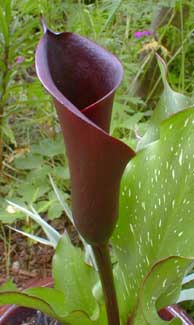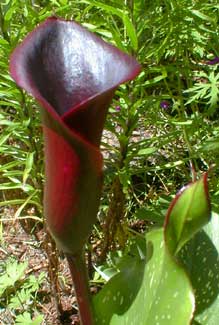
Edge of Night Calla Lily;
or, Black Arum Lily
I can tell you're a widow
By your black leather jacket & clown-white
A raven lily in your window
And the black scented candles for the night.
Here I stand in the middle
To bring you back to the light
But I'm no daffy down dilly
So do keep the raven lily.
-Paghat the Ratgirl
July 2009
July 2009
 'Edge of Night' calla lilies are developed for market in near laboratory conditions & are not hardy candidates for open gardens here in the Northwest. In very mild maritime climates where winters rarely fall into the twenties Fahrenheit, there is some chance they will survive winter, but losses should be expected, & most people grow them in pots that can be brought indoors part of the year.
'Edge of Night' calla lilies are developed for market in near laboratory conditions & are not hardy candidates for open gardens here in the Northwest. In very mild maritime climates where winters rarely fall into the twenties Fahrenheit, there is some chance they will survive winter, but losses should be expected, & most people grow them in pots that can be brought indoors part of the year.This was a 2004/2005 introduction, developed through Terra Nova Nurseries by Daniel M. Heims & Frank Patterson both of Oregon. The parent of this clone was Z. x rehmanii 'Schwarzwalder' (aka 'Black Forest'), a plum-black calla lily without the dark stem & dark leaf margins of 'Edge of Night.'
I've a tendency not to get brand new releases even if I like them, since after a couple of years the price usually goes down to normal. But Granny Artemis couldn't resist. She brought this home the very first time she saw it for sale, & we put it in an attractive pot, with a dwarf saxafrage in the same pot so it'd have something in it when the calla lily was dormant.
Three or four shiny speckled green leaves with black edges surround a funnelling spathe that is rightly described by Terra Nova as "a rich, velvety, purple black," on a deep purple stem. Really it is so deeply purple that the right has to be perfect before one realizes it isn't true black, as this is about as black as black plants can be.
Z. rehmanii cultivars tend to bloom quite briefly compared to the longer-lasting blooms of Z. aethiopica cultivars. But Z. rehmanii has more color varieties (from pink to yellow to black).
For both species, there is always a chance of losing them to winter chills, but losses would be more probable with Z. rehmanii if overwintered outdoors, hence the preference for potting them. They have improved flowering strength when rootbound which is another factor that makes them fine candidates for containers, though containered corms are even more at risk during a freeze.
Though our winter temperatures rarely fall into the twenties, 'Edge of Night' seems apt to be tender even so, as Terra Nova recommends lifting the bulb in autumn before first frost & store it for winter, or bring potted corms to cover.
We figured if it is really that sensitive then we probably won't have it for years because even though its potted & easily brought in, I'm just not inclined to bring pots indoors. I've a tendancy to take the sorry attitude toward tender perennials "if it can't live outdoors, too bad." That attitude paid off well with the Chocolate Cosmos which other locals lift each autumn but which I leave in the garden year-round without troubles.
After the leaves die back at mid-summer it does not want to be watered thereafter, but wants a dry dormancy of about three months, during which time many calla lily fans will hide the pot in a dark cool place, then drag it back out while it is still winter & let it get started again indoors, keeping it lightly moist. When last threat of frost has passed, it can again go outdoors.
'Edge of Night' can also do nicely as an outright houseplant if you're not the sort to forget to water what's indoors.
From 2005 to 2008, our raven-black calla lily did just fine never being brought indoors or babied in any manner. So it was quite a surprise when it did not return in 2009. I'd gotten used to the idea that it was hardier than promised. There was one big difference regarding this past winter, though, in contrast to previoius winters. It was an especially rainy winter, so I don't think it was the cold that killed the calla. I think the soil in the pot remained too wet too often & it rotted out.
So now alas that pot has just the dwarf saxafrage in it. We have some more potted callas, however, with sedums growing over the surface of a much larger container. And we just might get black ones again, too, & even try them directly in the garden rather than potted.
"Calla" means "Beautiful" sharing this meaning with a nymph of Artemis, amazonian Callisto, who became the Great Bear of Heaven. We may recall the calla lily as a symbol of sophisticated beauty in the art deco era, with lamps shaped like calla lilies being especially common.
Since white calla lilies were traditionally symbolic of purity, marriage, & wisdom, one might speculate a black one symbolizes decadence & lustiness.
The vaginal form of the calla lily lent it occasionally to be associated in Christian iconography with the Virgin Mary as the vessel of the divine child. But surely its lingering associations with the vagina, having already a phallus within, & its association with marriage ritual, predate Christianity. So it is really representative of a fertility goddess, such as were invariably goddesses both of Life & of Death, the latter represented by the calla lily's toxicity.
Many modern wicca practioners believe the calla lily of any color invokes Hecate, who we might wisely identify with Kali as All-mother, although for the great Mexican painter Diego Revera, the calla lily was symbolic of his personally beloved goddess, Freda Kahlo. Calla, Kali, Kahlo. Hmmmm...